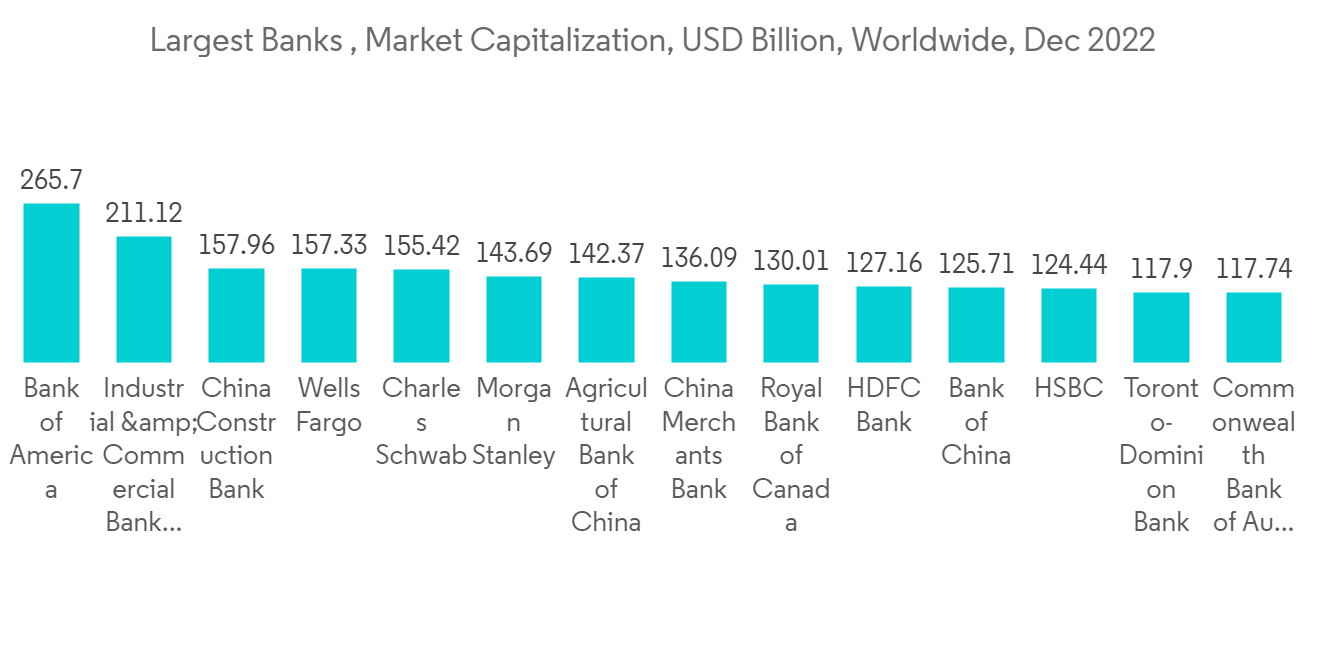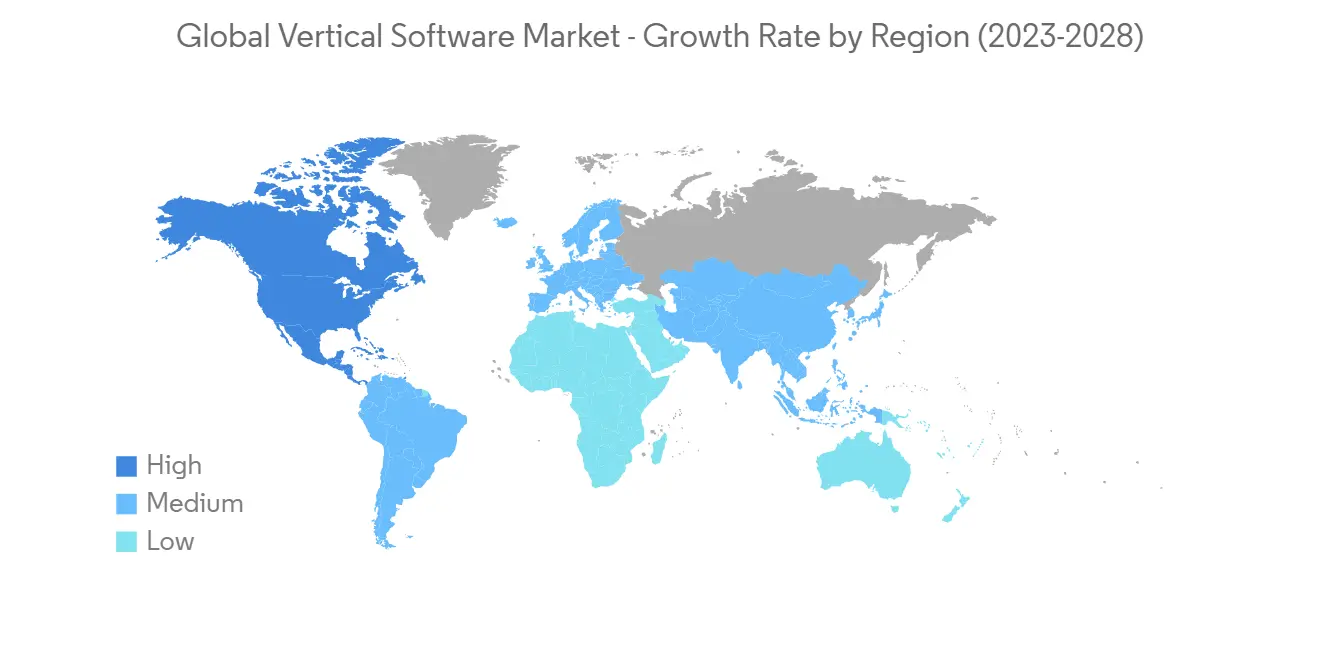 |
市場調査レポート
商品コード
1258787
バーティカルソフトウェア市場- 成長、動向、予測(2023年-2028年)Vertical Software Market - Growth, Trends, and Forecasts (2023 - 2028) |
||||||
● お客様のご希望に応じて、既存データの加工や未掲載情報(例:国別セグメント)の追加などの対応が可能です。 詳細はお問い合わせください。
| バーティカルソフトウェア市場- 成長、動向、予測(2023年-2028年) |
|
出版日: 2023年04月14日
発行: Mordor Intelligence
ページ情報: 英文 120 Pages
納期: 2~3営業日
|
- 全表示
- 概要
- 目次
バーティカルソフトウェア市場は、予測期間中に11.2 %のCAGRで推移すると予想されています。
バーティカルマーケットソフトウェアには、数多くの明確な利点があります。バーティカルマーケットソフトウェアは、業界特有の機能やプロセスにより効果的に対応することができます。また、水平市場向けソフトウェアと比較して、さまざまな機能や手順との優れた統合を実現することができます。このような特長から、バーティカルソフトウェア市場の市場規模は、予測期間中に多くの成長機会をもたらすと期待されています。
主なハイライト
- バーティカルソフトウェア市場のリーダーは、決済処理などの「統合サービス」をレイヤーケーキに追加する余裕を持っている。 決済処理、給与計算、融資など、金融サービスのほとんどはコモディティです。あなたは、多くの場合、より使いやすく、安価で、このソフトウェアとよりよく統合された、垂直方向に特化した提供物を供給することによって、垂直方向で信頼できるソフトウェアベンダーとして、一般的な第三者サプライヤーに勝利する権利があります。この方法の意義は、企業が顧客の懐に潜り込んでソフトウェアを買い足すことを求めないことです。その代わりに、顧客がすでに支払っているものを置き換えることで、クロスセルを「無料」と感じさせ、販売の摩擦を減らすことができます。
- 例えば、Shopifyは事業資金の調達と引き受けを行っています。キャッシュフローが見える業界別ソフトウェアビジネスは、特に融資の組成と引き受けに有利な立場にあります。例えば、Procoreは、建設会社が新しい仕事を受注した際に、建築資材の取得資金を支援するためのローンを提供しています。Truckstopは、トラック運送事業者が仕事を終えた後に、その債務額を担保に融資を行う。Mindbodyは、Mindbodyプラットフォームを通じて行われる将来の支払いに対して、キャッシングを提供しています。
- B2B2Cのバーティカルソフトウェア企業の中には、マーチャントではなく、消費者をマネタイズしようとする企業もあります。FareHarborは、アクティビティやツアーオペレーターの市場にソフトウェアを提供している企業です。競合他社の多くがオペレーターに会費を支払うのに対し、FareHarborは無料のソフトウェアを提供し、エンドユーザーに取引手数料を請求することで収益を得ています。FareHarborは、この画期的な価格設定により、より高価な競合他社に対して優位に立つことができました。
- パンデミック(世界的大流行)の最中、さまざまな業界がソフトウェア会社と協力し、顧客により良い体験を提供することに成功しました。例えば、ERPソリューションの著名なプロバイダーであるルートストック・ソフトウェアは、最近、この誤解を解くためにVertical Aerospace社と協力し、世界的にCOVID-19が流行する中、ルートストックのクラウドERPの導入をわずか3ヶ月半で完了させました。
- より多くのルールが存在し、規制コンプライアンス管理は様々な企業で発展してきました。規制コンプライアンスプロセスと戦略は、企業が商業的目標の達成に取り組む際の指針となります。企業は、すべての製品コンポーネントと生産手順が、関連するすべての法的要件と産業品質のベンチマークを満たすことを保証するために、コンプライアンスソフトウェアを採用しています。多くの産業のサプライチェーンにおいて、規制の制約はより厳しくなっています。気候変動に関連した環境問題、世界化とそれに伴う複数拠点からの規制遵守の追跡、満足、検証の必要性、そしてマスカスタマイゼーションは、増え続ける様々な製品をより少ないロットやバッチで規制遵守する必要があり、これらすべてがこうした圧力に寄与しています。
バーティカルソフトウェア市場動向
BFSIが市場を牽引すると予想される
- フィンテックは、顧客一人当たりの売上を増やし、製品をより強固なものにすることで、垂直型SaaSのGo-to-Marketチャネルに影響を与えます。言い換えれば、フィンテックは、生涯価値(LTV)を向上させながら、顧客獲得コスト(CAC)を維持(減少させないまでも)します。例えば、加入者1人当たり月額250米ドルの収入を得たMindbodyは、ソフトウェアパッケージの料金を月額150米ドル、年平均で1800米ドル課金する一方で、支払い収入で月額100米ドルを追加で稼いです。
- さらに、フィンテックはLTVを大幅に向上させることができるため、垂直型SaaS企業は、フィンテックを主要な収益源とする前に、SaaS製品をより安く(あるいは無料で)提供し、デジタル化を躊躇する顧客ベースを誘引することも考えられます。食品卸売業者向けのオペレーティングシステムであるSiloは、現在、顧客にソフトウェアの料金を請求しておらず、これにより、これまでソフトウェアの導入に抵抗があった業界で効果的に顧客を獲得することができました。
- CompaniesMarketCapによると、2022年12月31日現在、JPモルガン・チェースは、時価総額で世界最大の銀行です。JPモルガン・チェースの時価総額は当時約3,930億米ドルで、バンク・オブ・アメリカの時価総額(約2,657億米ドル)を大きく上回っています。また、JPモルガン・チェースは、総資産では米国最大の銀行だが、世界的には第6位に過ぎないです。このような巨大な銀行の時価総額は、バーティカルソフトウェア企業にとって、これらの銀行に自社のソリューションを展開する機会を創出することになります。
- 金融分野におけるバーティカルソフトウェアの需要が高まる中、各社は市場シェアを獲得するために様々な製品を提供しています。例えば、2022年7月、金融サービスソフトウェアのソリューションプロバイダーおよびプラットフォームであるSAP Fioneerは、新しい垂直製品戦略を立ち上げ、顧客提供を大幅に変更しました。垂直戦略を用いて、3つのプラットフォームが個々の市場や顧客のニーズに適応したITソリューションを提供し、複雑化する金融界を交渉できるようにします。
- 同様に、2022年2月、新しいDatabricks Lakehouse金融サービスエディションは、銀行、保険、資本市場のお客様を対象としています。ソリューションアクセラレータ、不正検知や持続可能性といった金融サービスのユースケースに対応したソフトウェアコード、この分野で一般的に利用されているデータセットや第三者データプロバイダーへのインターフェースなど、業界固有の技術コンテンツでプラットフォームを強化します。データブリックスによると、金融サービス向けレイクハウスは、マルチクラウド環境において、あらゆるデータタイプのリアルタイム分析、ビジネスインテリジェンス、AIタスクを提供します。

北米が主要シェアを占めると予想される
- Flexera Softwareが北米のIT企業幹部514名を対象に実施した調査によると、49%が、コラボレーション・プラットフォームやサービス、コミュニケーションなどへの投資に注力する企業が増え、同地域のIT投資が増加すると予想しています。このことは、コラボレーティブ・ホワイトボード・ソフトウェア市場のサプライヤーにとって、新たな可能性を開くことになります。サンフランシスコに本社を置くMicro社は、Dell、Cisco、Deloitte、Okta、Pivotalといったフォーチュン500社に名を連ねる同社のコラボレーティブホワイトボードのユーザー数2,000万人を誇っています。
- この地域では、従来のマーケティングに比べ、デジタルオムニチャネルマーケティングへの移行が進んでいるため、マーケティングオートメーションソフトウェアの導入が進んでいます。米国マーケティング協会とデューク大学によるCMOサーベイ(n=356)によると、2021年1月、米国のB2B製品マーケティング担当者は、翌年に従来の広告への支出が0.61%減少する一方、デジタルマーケティングの支出は14.32%増加すると予測されたことを示唆しました。
- さらに、2022年3月には、メディア・エンターテインメント業界向けの権利・財務管理プラットフォームのリーディングカンパニーであるRightslineがREAL Software Systemsを買収し、中核となる知的財産権管理サービスを拡張してエンドツーエンドの財務・ロイヤリティのワークフローを完全にサポートすると同時に、市場をメディア・エンターテインメントからゲーム、出版、消費財、生命科学、ハイテクなどの世界な業界に拡大しました。
- 2022年12月、モントリオールを拠点に垂直市場向けソフトウェアの買収と開拓に注力するValsoft Corporation Inc.は、北米の企業資源計画(ERP)と倉庫管理システム(WMS)ソフトウェアサプライヤーであるApero Solutions Inc.の買収を発表することを嬉しく思っています。
- 同様に、2023年1月には、米国の政府機関やNGO向けにファンド会計ソリューションを提供するAccufund, Inc.が、i3 Verticals, Inc.に買収されました。Accufundの会計ソフトウェアソリューションは、公共セクター領域における企業の市場開拓戦略を大きく改善することになります。

バーティカルソフトウェア業界の概要
バーティカルソフトウェア市場は、複数の企業が存在するため、競争は緩やかです。市場のプレーヤーは、製品ポートフォリオを拡大し、地理的範囲を広げ、主に市場で競争力を維持するために、製品革新、合併、買収などの戦略を採用しています。
2022年12月、Constellation Software Inc.とその子会社Lumine Group Inc.は、米国に拠点を置くメディア垂直市場ソフトウェアサプライヤーであるWideOrbit Inc.(以下、WideOrbit)との正式契約と合併計画を発表しました。WideOrbit社はルミネグループの完全子会社となり、取引成立後はルミネグループの企業ポートフォリオの中で自律的なビジネスユニットとして運営される予定です。
2022年11月、バーティカル・インテリジェンスのソフトウェアとソリューションを提供するNowVertical Group Inc.は、メキシコシティの国際フラッグキャリア航空会社Grupo Aeromexico S.A.B. de C.V.との新しい契約を発表したことを喜ばしく思っています。本契約により、NOWはアエロメヒコのデータガバナンスプログラムの推進を支援し、データドリブンな航空会社という目標を達成するために必要なビジョンと道筋を確立していきます。
その他の特典:
- エクセル形式の市場予測(ME)シート
- 3ヶ月のアナリストサポート
目次
第1章 イントロダクション
- 市場の定義と範囲
- 調査の前提条件条件
第2章 調査手法
第3章 エグゼクティブサマリー
第4章 マーケット洞察
- 市場概要
- 産業の魅力- ポーターのファイブフォース分析
- 供給企業の交渉力
- 消費者の交渉力
- 新規参入業者の脅威
- 代替品の脅威
- 競争企業間の敵対関係の強さ
- COVID-19の市場に対する影響度評価
第5章 市場力学
- 市場促進要因
- 企業に特化したソリューションとドメインに特化したノウハウの需要の増加
- 市場の抑制
- 実装の複雑さとアジリティの欠如
第6章 市場セグメンテーション
- 組織規模別
- 中小企業
- ラージエンタープライズ
- エンドユーザー産業別
- BFSI
- 教育機関
- 法務・官公庁
- エンタテインメントとホスピタリティ
- 衣料品・アパレル
- ヘルスケア
- 農作業・農業
- その他のエンドユーザー産業
- 地域別に見る
- 北米
- 欧州
- アジア太平洋地域
- ラテンアメリカ
- 中東・アフリカ地域
第7章 競合情勢
- 企業プロファイル
- Constellation Software
- Verisk Analytics
- Athena
- Bio-Logic Inc.
- vetBadger
- FastBound
- Mail Technologies Inc
- Granular
- FarmBite
- RenderForest
第8章 市場の展望
The vertical software market is expected to register a CAGR of 11.2 % over the forecasted period. Vertical market software includes a number of distinct advantages. Vertical market software assists in more effectively addressing industry-specific features and processes. In comparison to software for the horizontal market, it also assists organizations in obtaining superior integration with various functionalities and procedures. As a result of these features, the vertical software market size is expected to witness numerous growth opportunities during the forecasted period.
Key Highlights
- Vertical software market leaders have the luxury of adding "integrated services" such as payment processing to their layer cake. Most financial services, such as payment processing, payroll, and lending, are commodities. You have the right to win against generic third-party suppliers as the trusted software vendor in your vertical by supplying a vertical-specific offering that is often more useable, inexpensive, and better integrated with this software. This method's significance is that businesses do not require customers to dip into their pockets and purchase more software. Firms instead replace something that customers already pay for, making the cross-sell feel "free" and lowering sales friction.
- For example, Shopify sources and underwrite business financing. Vertical software businesses with cash flow visibility are especially well-positioned to originate and underwrite loans. For example, Procore provides loans to assist construction companies in financing the acquisition of building materials when new work is awarded to them. Truckstop makes loans to trucking businesses after completing work that is secured by the amount they owe. Mindbody provides a cash advance against future payments made via the Mindbody platform.
- Some B2B2C vertical software companies are attempting to monetize the consumer rather than the merchant. FareHarbor is a software provider to the activity and tour operator markets. While most of its competitors paid operators a membership fee, FareHarbor provided free software and gained revenue by charging end-users a transaction fee. FareHarbor gained an advantage over more expensive competitors thanks to this revolutionary pricing approach.
- During the pandemic, various vertical industries collaborated with software firms to provide a better experience for customers. For instance, rootstock software, a prominent provider of ERP solutions, recently collaborated with Vertical Aerospace to debunk this misconception, completing the implementation of Rootstock's Cloud ERP in just three and a half months and amid the global COVID-19 outbreak.
- There have been more rules, and regulatory compliance management has grown in many different enterprises. Regulatory compliance processes and strategies guide organizations as they work to achieve their commercial objectives. Companies employ compliance software to ensure that all product components and production procedures meet all relevant legal requirements and benchmarks for industrial quality. Regulatory constraints are becoming more intense along many industry supply chains. Climate change-related environmental concerns, globalization and the resulting need to track, satisfy, and verify regulatory compliance from multiple locations, and mass customization, which necessitates regulatory compliance for an ever-increasing various of products in an ever-smaller variety of lots or batches, all contribute to these pressures.
Vertical Software Market Trends
BFSI is Expected to Drive the Market
- Fintech influences vertical SaaS go-to-market channels by increasing revenue per customer and making the product stickier. In other words, fintech maintains, if not decreases, the cost of customer acquisition (CAC) while improving lifetime value (LTV). Mindbody, for example, earned USD 250 per month per subscriber; while it charged USD 150 per month, or USD 1800 per year on average, for its software package, it made an additional USD 100 per month from payments income.
- Furthermore, because fintech can drastically enhance LTV, vertical SaaS companies might offer their SaaS product for cheaper (or even for free) to entice a client base that would otherwise be hesitant to digitize before piling on fintech goods as the primary revenue lever. Silo, an operating system for wholesale food wholesalers, does not now charge its customers for its software, which has allowed it to effectively land customers in an industry that has previously been resistive to software adoption.
- According to CompaniesMarketCap, As of December 31, 2022, JPMorgan Chase was the largest bank in the world by market capitalization. JPMorgan Chase's market capitalization was around USD 393 billion at the time, much higher than Bank of America's market capitalization, which was around USD 265.7 billion. JPMorgan Chase is also the largest bank in the United States in total assets but only the sixth largest globally. The such huge market capitalization of banks would create an opportunity for vertical software companies to deploy their solutions in those banks.
- With the rise in demand for vertical software in the financial sector, firms are providing various products to capture the market share. For instance, in July 2022, SAP Fioneer, a financial services software solutions provider and platform, launched a new vertical product strategy that drastically altered its client offering. Using a vertical strategy, three platforms will deliver IT solutions adapted to the individual market and client needs, allowing them to negotiate an increasingly complex financial world.
- Similarly, in February 2022, the new Databricks Lakehouse financial services edition aims at customers in the banking, insurance, and capital markets. It enhances the platform with industry-specific technical content such as solution accelerators, software code for financial service use cases such as fraud detection and sustainability, and interfaces to data sets and third-party data providers typically utilized by the sector. According to Databricks, the Lakehouse for Financial Services provides real-time analytics, business intelligence, and AI tasks on all data types in multi-cloud environments.

North America is Expected to Hold Major Share
- According to a Flexera Software poll of 514 IT executives in North America, 49% anticipate that IT spending in the region will increase as more firms focus on investing in collaboration platforms and services, communication, and other areas. This opens up new possibilities for suppliers in the collaborative whiteboard software market. Micro, a San Francisco-based firm, boasts 20 million users for its collaborative whiteboard, which includes Fortune 500 companies like Dell, Cisco, Deloitte, Okta, and Pivotal.
- The adoption of marketing automation software has been increasing in the region as there has been a shift to digital omnichannel marketing compared to traditional marketing. According to the CMO Survey by American Marketing Association and Duke University (n=356), in January 2021, B2B product marketers in the United States suggested that their spending on traditional advertising was expected to decline by 0.61% in the following year, while the digital marketing spending was projected to increase by 14.32%.
- Further, in March 2022, Rightsline, the leading rights and finance management platform for the media and entertainment industry, acquired REAL Software Systems to extend its core IP rights management services to fully support end-to-end financial and royalties' workflows while simultaneously expanding its market from media and entertainment into gaming, publishing, consumer products, life sciences, and high tech, among other global industries.
- In December 2022, Valsoft Corporation Inc., a Montreal-based business focusing on vertical market software acquisition and development, is happy to announce the acquisition of Apero Solutions Inc., a North American Enterprise Resource Planning (ERP) and Warehouse Management System (WMS) software supplier.
- Similarly, in January 2023, Accufund, Inc., a provider of fund accounting solutions for government bodies and NGOs in the United States, was acquired by i3 Verticals, Inc. Accufund's accounting software solutions will significantly improve enterprises' go-to-market strategy in the Public Sector area.

Vertical Software Industry Overview
The vertical software market is moderately competitive owing to the presence of multiple players. The players in the market are adopting strategies like product innovation, mergers, and acquisitions to expand their product portfolio, expand their geographic reach, and primarily stay competitive in the market.
In December 2022, Constellation Software Inc. and its subsidiary Lumine Group Inc. announced a formal agreement and merger plan with WideOrbit Inc. ("WideOrbit"), a media vertical market software supplier based in the United States. WideOrbit will become a completely owned subsidiary of Lumine Group and will operate as an autonomous business unit within the Lumine Group's portfolio of companies after the deal is finalized.
In November 2022, NowVertical Group Inc., a vertical intelligence software and solutions firm, is thrilled to announce a new contract with Grupo Aeromexico S.A.B. de C.V., Mexico City's international flag carrier airline. Under the terms of the agreement, NOW will assist Aeromexico in advancing its data governance program, establishing the vision and path it will need to take to progress and achieve its aim of being a data-driven operator.
Additional Benefits:
- The market estimate (ME) sheet in Excel format
- 3 months of analyst support
TABLE OF CONTENTS
1 INTRODUCTION
- 1.1 Market Definition and Scope
- 1.2 Study Assumptions
2 RESEARCH METHODOLOGY
3 EXECUTIVE SUMMARY
4 MARKET INSIGHTS
- 4.1 Market Overview
- 4.2 Industry Attractiveness - Porter's Five Forces Analysis
- 4.2.1 Bargaining Power of Suppliers
- 4.2.2 Bargaining Power of Consumers
- 4.2.3 Threat of New Entrants
- 4.2.4 Threat of Substitute Products
- 4.2.5 Intensity of Competitive Rivalry
- 4.3 Assessment of Impact of COVID-19 on the market
5 MARKET DYNAMICS
- 5.1 Market Drivers
- 5.1.1 Increase in Demand of Enterprise-specific Solution and Domain-specific Expertise
- 5.2 Market Restrain
- 5.2.1 Implementation Complexities and Lack of Agility
6 MARKET SEGMENTATION
- 6.1 By Organization Size
- 6.1.1 Small and Medium Enterprise
- 6.1.2 Large Enterprise
- 6.2 By End-User Industry
- 6.2.1 BFSI
- 6.2.2 Educational Institution
- 6.2.3 Legal and Government
- 6.2.4 Entertainment and Hospitality
- 6.2.5 Clothing and Apparel
- 6.2.6 Healthcare
- 6.2.7 Farming and Agriculture
- 6.2.8 Rest of the End-User Industries
- 6.3 By Geography
- 6.3.1 North America
- 6.3.2 Europe
- 6.3.3 Asia-Pacific
- 6.3.4 Latin America
- 6.3.5 Middle East and Africa
7 COMPETITIVE LANDSCAPE
- 7.1 Company Profiles
- 7.1.1 Constellation Software
- 7.1.2 Verisk Analytics
- 7.1.3 Athena
- 7.1.4 Bio-Logic Inc.
- 7.1.5 vetBadger
- 7.1.6 FastBound
- 7.1.7 Mail Technologies Inc
- 7.1.8 Granular
- 7.1.9 FarmBite
- 7.1.10 RenderForest
